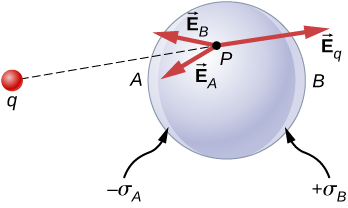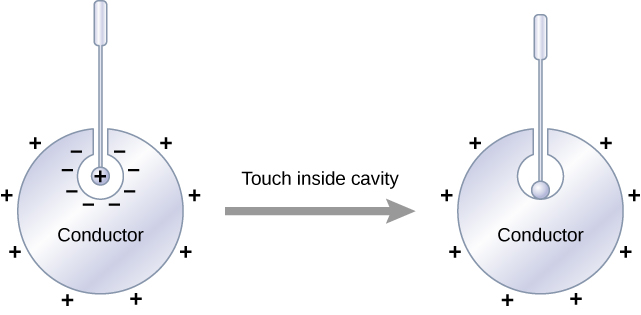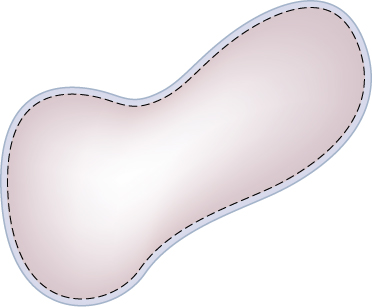| << Chapter < Page | Chapter >> Page > |

The redistribution of charges is such that the sum of the three contributions at any point P inside the conductor is
Now, thanks to Gauss’s law, we know that there is no net charge enclosed by a Gaussian surface that is solely within the volume of the conductor at equilibrium. That is, and hence
An interesting property of a conductor in static equilibrium is that extra charges on the conductor end up on the outer surface of the conductor, regardless of where they originate. [link] illustrates a system in which we bring an external positive charge inside the cavity of a metal and then touch it to the inside surface. Initially, the inside surface of the cavity is negatively charged and the outside surface of the conductor is positively charged. When we touch the inside surface of the cavity, the induced charge is neutralized, leaving the outside surface and the whole metal charged with a net positive charge.

To see why this happens, note that the Gaussian surface in [link] (the dashed line) follows the contour of the actual surface of the conductor and is located an infinitesimal distance within it. Since everywhere inside a conductor,
Thus, from Gauss’ law, there is no net charge inside the Gaussian surface. But the Gaussian surface lies just below the actual surface of the conductor; consequently, there is no net charge inside the conductor. Any excess charge must lie on its surface.

This particular property of conductors is the basis for an extremely accurate method developed by Plimpton and Lawton in 1936 to verify Gauss’s law and, correspondingly, Coulomb’s law. A sketch of their apparatus is shown in [link] . Two spherical shells are connected to one another through an electrometer E, a device that can detect a very slight amount of charge flowing from one shell to the other. When switch S is thrown to the left, charge is placed on the outer shell by the battery B. Will charge flow through the electrometer to the inner shell?
No. Doing so would mean a violation of Gauss’s law. Plimpton and Lawton did not detect any flow and, knowing the sensitivity of their electrometer, concluded that if the radial dependence in Coulomb’s law were , would be less than S. Plimpton and W. Lawton. 1936. “A Very Accurate Test of Coulomb’s Law of Force between Charges.” Physical Review 50, No. 11: 1066, doi:10.1103/PhysRev.50.1066 . More recent measurements place at less than E. Williams, J. Faller, and H. Hill. 1971. “New Experimental Test of Coulomb’s Law: A Laboratory Upper Limit on the Photon Rest Mass.” Physical Review Letters 26 , No. 12: 721, doi:10.1103/PhysRevLett.26.721 , a number so small that the validity of Coulomb’s law seems indisputable.

Notification Switch
Would you like to follow the 'University physics volume 2' conversation and receive update notifications?